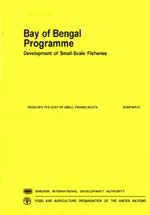
WORKING PAPERS - BOBP/WP/27
Reducing The Fuel Costs Of Small Fishing Boats
by
0. Gulbrandsen
Consultant (Naval Architect), Bay of Bengal Programme
 |
WORKING PAPERS - BOBP/WP/27 Reducing The Fuel Costs Of Small Fishing Boatsby |
|
Executing Agency: FOOD AND AGRICULTURE ORGANIZATION OF THE UNITED NATIONS Funding Agency: SWEDISH INTERNATIONAL DEVELOPMENT AUTHORITY Development of Small-Scale Fisheries in the Bay of Bengal. Madras, India, July 1986 |
| The designations employed and the presentation of material in this publication do not imply the expression of any opinion whatsoever on the part of the Food and Agriculture Organization of the United Nations concerning the legal status of any country, territory, city or area or of its authorities, or concerning the delimitation of its frontiers or boundaries. |
All rights reserved. Reproduction and dissemination of material in this information product for educational or other non-commercial purposes are authorized without any prior written permission from the copyright holders provided the source is fully acknowledged. Reproduction of material in this information product for resale or other commercial purposes is prohibited without written permission of the copyright holders. Applications for such permission should be addressed to the Chief, Publishing and Multimedia Service, Information Division, FAO, Viale delle Terme di Caracalla, 00100 Rome, Italy or by email to [email protected]
© FAO 2004
|
The first part of this paper describes the principles of power requirements for small fishing boats and details ways of saving fuel which can be applied both with existing boats and new boats. It also illustrates by example how to estimate the savings from measures to conserve fuel. The second part of the paper describes fuel consumption trials carried out in Sri Lanka. During the trials the two most common Sri Lankan boats - the 18 footer and 28 footer — were used with different engines, propellers and hull conditions, and actual fuel consumption was recorded. The fuel consumption performance of two BOBP craft - SRL-14 and SAL-15 - was tested in comparison with that of the standard 28-footer of Sri Lanka; the fuel performance of another BOBP craft, SRL-17, was compared with that of Sri Lanka’s standard 18-footer. The results of the trials confirmed the validity of the principles and fuel-saving recommendations described in the first part. The trials were conducted in 1982 at the request of the Ministry of Fisheries, Sri Lanka. A report was submitted to the Ministry soon after the trials. |
PREFACE
PART I: METHODS OF FUEL SAVING
1. INTRODUCTION
1.1 Alternative fuel saving measures
2. MAIN FACTORS INFLUENCING FUEL CONSUMPTION
2.1 Speed
2.2 Hull design
2.3 Engine power and operating range
2.4 Reduction gear and propeller
2.5 Type of engine
2.6 Use of sail
2.7 Hull fouling
2.8 Engine maintenance
2.9 Mode of operation
PART II: FUEL CONSUMPTION TRIALS IN SRI LANKA
1. Types of boats tested and measuring method
2. Results of trials
FIGURES
1. Power-speed diagram
2. Estimated fuel consumption
3. Engine power and operating range
4. Minimum clearance:propeller/hull
5. Outboard kerosene engine versus inboard diesel engine
6. The IND-20B design with Gunter rig
7. 18 ft. Sri Lankan (5.5 m) boat
8. 28 ft. Sri Lankan (8.5 m) boat
9. Fuel consumption measuring device
10. 18 ft. boat and SRL-17 : fuel consumption per nautical mile
11. 28 ft. boat, SRL-14 and SRL-15: fuel consumption per nautical mile
12. 28 ft. boat with 30 hp engine fuel consumption per nautical mile
APPENDICES
1. Cost comparison between outboard kerosene engine and diesel inboard engine for a 18 ft. FRP boat in Sri Lanka
2. Main particulars of the boat tested
3. Fuel consumption data sheet
PUBLICATIONS OF THE BAY OF BENGAL PROGRAMME